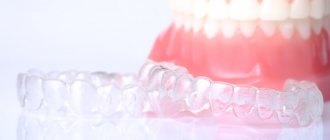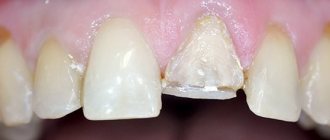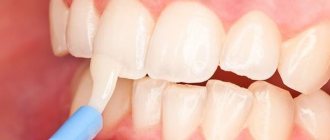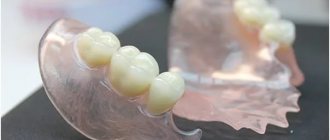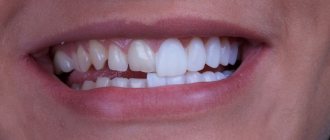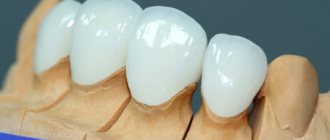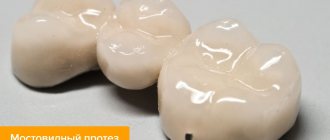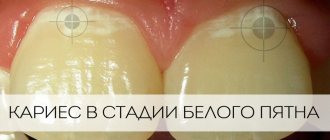Reading time: 7-8 minutes
Author of the article: Tsurkan Vladislav Gennadievich
Doctor-expert
Specialization: Dentist-orthopedist
Total work experience: since 2021
- How veneers are placed using the direct method
The installation of veneers is performed for the purpose of aesthetic restoration of the dentition. The method is significantly more effective than professional cleaning and any bleaching methods. To understand how veneers are installed on teeth, it is necessary to take a closer look at the existing methods and familiarize yourself with the list of actions of the dentist.
What kind of design is this and its features
What kind of dentures are these and how are removable dentures different from all the others? Removable veneers are veneers that can be removed. It would seem nothing complicated. But in this simplicity lies either an advertising ploy - it misleads patients, or such veneers will soon have to be replaced with permanent ones - which in theory they should be.
It is worth saying that not a single self-respecting orthopedic dentist will offer a patient removable “veneers” as an option to improve the aesthetics of a smile. What's the point here? In general, veneers1 are non-removable microprostheses - overlay plates on the upper and lower front teeth, which make them more beautiful in shape and shade. But such onlays are made in a dental laboratory (this is important!) within a few days or weeks. During this time, the patient is given temporary plates - composite or plastic, which will soon be removed. They are needed to protect the ground teeth from damage and temporarily give them a natural look.
Those removable veneers that are offered to patients on websites on the Internet or in advertising videos and booklets are most often similar to conventional silicone dentures for the entire jaw. They also resemble the joke “jaws” that people wear to masquerades, and even chewing gum in the shape of jaws. They attach very poorly to the mouth and, according to patients, they are completely impossible to wear. You can see how “natural and natural” such products look before and after installation - see the photo.
Indications
Microprosthetics in some cases is the best solution to the problem.
Dentists recommend installing veneers in the following cases:
- For chips, cracks and uneven enamel.
- Change in color that cannot be bleached.
- Uneven row.
- For crooked or underdeveloped teeth.
- Pathological abrasion of enamel.
Russian technologies for manufacturing composites differ from Western ones. In European dental clinics, onlays are made in a special dental laboratory, and impressions are used after grinding and preparation. In Russia, dental plates are more like ordinary fillings. They are installed directly into the patient's mouth.
Types of removable “veneers”
This group includes the following types of structures (although not all of them have the right to be called veneers):
- temporary onlays for teeth: patients wear them for about 2 weeks or more - up to 2 months. During this time, permanent onlays are made in the laboratory from ceramics, zirconium dioxide, and ceramic composite. Moreover, for both temporary and permanent overlays, the rule applies - each tooth has its own individual veneer, made from impressions,
- DenMat's Snap-On Smile Dentures: These are temporary dentures that look like veneers or crowns bonded together. They can be worn over the entire dentition or on a “problem” sector. Snap-On Smile not only improves the aesthetics of a smile, but can replace several missing teeth in a row. They are made individually from impressions sent to the manufacturer’s laboratory in the USA,
- removable “veneers” on teeth, “dental onlays” or “false teeth”, which can be purchased on the Internet, pharmacies or cosmetics stores: they look like a silicone prosthesis for the entire row, or single onlays that are glued at home yourself.
As for the last variety, there is no talk here of any individualized approach or taking casts. These “dentures” have a standard shape and are suitable for a person with perfectly straight teeth. But in any case, they will not stick well and will come off with a little pressure. So with such a “Hollywood smile” you can only smile (but even this is not a fact), but you won’t be able to chew food.
Zirconium dioxide crown on an implant for all 55,000 rubles instead of 80,000 rubles!
OSSTEM implant (South Korea), individual zirconium abutment, gum former, impression taking.
Creation of a Prettau zirconium crown using 3D modeling technology. Consultation with 2 doctors: an orthopedist and an implantologist for free! Call now or request a call
Opening hours: 24 hours a day - seven days a week
What materials are they made from?
Overlay removable veneers are made of polymers, silicone, polypropylene, and plastic in light shades. These are inexpensive materials, they are easy to process and can be easily painted in enamel colors. But we must understand that even in professional dentistry such materials are used only on a temporary basis, because they have low performance characteristics. The materials are softer and more fragile than those used for real microprostheses. They also have irregularities and pores on the surface, into which dietary fiber and dyes become clogged.
Advantages and disadvantages
The advantages or benefits, if you can call them that, are that for not very much money you can get a new look for some kind of masquerade or photo shoot. Then there are the disadvantages, which are mentioned by reviews from dentists and people who decide to buy removable dental veneers. The disadvantages of removable dental veneers are as follows:
- poor fixation in the oral cavity,
- the risk of getting into an awkward situation in society,
- not very aesthetic appearance,
- rapid coloring of lining materials with food coloring, tobacco smoke, etc.,
- discomfort when wearing: such pads are made according to a template, so they will be uncomfortable after installation. After all, absolutely every person has their own individual parameters for the shape and inclination of their teeth, their sizes - it is impossible to measure everyone with one “ruler”,
- unpleasant “chemical” smell or taste from materials,
- risk of complications: damaged enamel, pulpitis, injuries to teeth and gums, chemical and thermal burns, allergic reactions to materials, risk of choking on a peeling pad or swallowing remaining adhesive.
“I placed an order in one group and was led by praise and a large audience. And I was very pleased with the price - it was only 500 rubles, to be honest. But on the day I received it, it turns out I was added to the blacklist. And I couldn’t leave my not at all positive review. These turned out to be not veneers at all, but some kind of toys, just to scare children with them. They do not stick to the teeth and fall out constantly. In general, horror!!!"
Marina_99, review from the woman.ru forum
Recovery period
There is no special rehabilitation period for installed veneers on the front teeth, so immediately after fixing the structures, you can return home to your normal lifestyle. However, in order for the products to last as long as possible, it is necessary to follow the doctor’s recommendations for oral care.
In most cases, a follow-up visit to the dentist is required so that the specialist can assess the condition of the gums and its reaction to the manufactured microprosthesis, and also check the position of the veneer on the front tooth surface and the reliability of the fixation.
Sometimes, after veneering vital teeth, hypersensitivity may occur, so a course of desensitizers will be required. In particularly difficult situations, to eliminate the increased response of teeth to thermal irritants, it is necessary to remove the pulp, and sometimes to cover the tooth with a metal-ceramic crown.
No special care is required for teeth covered with veneers:
- it is necessary to carry out daily oral hygiene using a brush and paste, which will allow the structure to maintain its shine and original appearance;
- it is advisable to limit foods that can leave pigmentation on the teeth, especially cigarettes, strong black tea, beets and blueberries;
- in order to avoid accidental chipping of part of the plate, increased chewing pressure on the front teeth should be avoided;
- Once every six months, visits to the dentist are required for a professional examination and possible correction of the product.
Veneers installed on the front teeth allow you to quickly correct aesthetic defects in your teeth and make your smile more attractive. To fix them, minimal grinding of the enamel is required, which is a less traumatic method of restoration than covering teeth with metal-ceramic crowns.
However, before veneering, you need to carefully study all the pros and cons of the procedure and consult a dentist about the possibility of installing such microprostheses.
How to use removable veneers
How to install and remove removable “veneers” will depend on their type. If the product is in the shape of a full jaw, then they are simply put on the teeth from above and removed from them by hand. Some sellers write that you first need to put the structure in hot water for a few minutes - almost boiling water - and then put it on. But in this case, there is a real risk of burning the gums and overheating the dentinal layer (it is located under the enamel), which can provoke pulpitis. Not to mention the discomfort of the installation process - some people report that it is painful or too hot for the teeth.
Removable “veneers”, which imitate real ones in their shape (but are sold in packs of 70 pieces, and are not made individually), are supposed to be fixed with a special adhesive using a brush and tweezers. And all this on your own at home. But if dentists use only professional formulations with proven components, then it is completely unknown what will end up in the package with “veneers”. It will be good if it is harmless glue (even if it comes off quickly). And if you come across a toxic substance that is difficult to remove, you will have to urgently seek medical help.
What is better to choose?
If you understand the question of which removable “veneers” are better, then the only option would be Snap-On Smile dentures. They are made individually and from quality materials. But, since the plant is located in the USA, the patient will have to wait about 1-2 months, and the main waiting time will be spent on transportation. Again, you will have to first visit an orthopedist to take impressions and sanitize the oral cavity. As a result, the final cost of treatment can be close to installing real veneers.
Only until 30.09 South Korean implant Osstem - 19,900 rubles.
Hurry up to sign up for a free consultation and lock in promotional prices.
Call now or request a call
Opening hours: 24 hours a day - seven days a week
Dental veneers at home
The ceramic plate is checked for consistency in color and shape. She dresses several times to check the bite and make adjustments. There should be no feeling of discomfort while eating or smiling.
After fitting, the plate itself and the oral cavity are cleaned to prevent the penetration of germs. Veneers are made rough on the inside. The teeth are coated with gel to make them rougher for better grip. For fixation, use a little cement paste, which hardens well after directing the light flux.
The remaining cement is removed and the bite is checked again.
How much does a “Hollywood” smile cost?
How much do removable dental veneers cost? If you study the offers on various sites, the average price will be 1,200 rubles for a complete “transformation” of your smile. But, as practice and reviews of people who have decided to make such a change in appearance show, this is money down the drain. In reality, such products will not make your smile more beautiful, and they are impossible to wear.
If the patient is interested in the cost of temporary veneers, which need to be worn while the permanent ones are being made, then their cost, as a rule, is already included in the overall price tag. Those. there will be no additional costs. Classic non-removable ceramic onlays for teeth cost from 15 thousand rubles and more - it all depends on the cost of materials and methods of processing them. By the way, if necessary, the doctor will be able to remove them and install new ones if the need arises.
1Gurel G. Ceramic veneers, 2007.
Your questions and answers
QUESTION I bought removable veneers online, but I cannot attach them to my teeth. They fall off constantly. Tell me how to do this better? Alexandra
ANSWER Hello, Alexandra. Unfortunately, there is nothing we can do here. Because these are not veneers at all, but their imitation. Real veneers are installed in dentistry using a special adhesive composition - and remain on it for years. Also, real veneers are made based on impressions of the patient’s dentition, i.e. they are individual and precisely adjusted to the parameters of a particular person. Whereas “veneers from the Internet” are template overlays made according to standards known only to the manufacturers themselves. That's why they don't stick to the teeth. The use of any independently selected adhesives is unacceptable, as this can only harm yourself. Therefore, we do not recommend wearing these products. But you can use them for creativity, crafts - whatever your imagination allows.
Author: Nepochatykh V.V. (Thank you for your help in writing the article and the information provided)
What problems do consumers complain about with veneers and lumineers?
Are there any disadvantages of the procedure? Before fixing the linings to ensure maximum reliable adhesion, a specialist carries out a special treatment of the protective layer. Its surface is etched with acid, as a result of which it changes irreversibly, so after removing the veneer, repeated correction will be required. With the help of a thin plate, you cannot get rid of all existing defects; sometimes it is impossible to hide the color or change a strong curvature if composite materials are used since they are opaque, they will be visible to others, they will stand out against the background of neighboring teeth.
Without preliminary grinding, the fixed device will visually make your own tooth somewhat thicker, and this will negatively affect aesthetic indicators. If there is no preliminary preparation, there is a danger of plaque accumulation in the cervical area, an inflammatory process in the gums may also begin, and secondary caries may begin to develop.
- And this is what the guy looks like without a false smile, by the way.
- Due to their small size, they are easy to lose or even swallow.
- If there are any defects or diseases, it is necessary to get rid of them before the procedure, because otherwise, if the teeth are severely damaged or their color changes, the defect will become noticeable to others, worsening the aesthetics of the smile.
- According to Indy100, Ben vowed never to buy anything online again and admitted that £42 was his worst investment.
- Having studied many opinions of patients who have experienced the procedure, we can conclude that a positive result largely depends on the qualifications of the doctor:
The service life of composite devices does not exceed four years, after which they should be replaced. Such devices cannot be repaired if chips or cracks suddenly occur, only complete replacement. They are fragile, short-lived and unreliable. After fixing them, it is necessary to limit the pressure and load on the front group of teeth; do not bite nails, pens or pencils, do not open bottles, do not chew nuts or other too hard food, even if you want to eat an apple, it is not recommended to bite it - it is better to cut it into pieces and only then use it.
